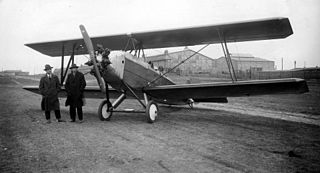The Central Centaur IV, a.k.a. Central C.F.5, was a British civil two/three-seat biplane aircraft produced by Central Aircraft Company Limited of London.

The Albatros L 75 Ass was a German trainer biplane of the 1920s. Of conventional configuration, it seated the pilot and instructor in separate, open cockpits. The wings were single-bay, equal-span, and had a slight stagger. Production continued after Albatros was absorbed by Focke-Wulf.

The de Havilland DH.29 Doncaster was a British long-range high-wing monoplane of the 1920s built by de Havilland.

The BAT F.K.26 was a British single-engined four-passenger biplane transport aircraft produced by British Aerial Transport Company Limited of London at the end of World War I.

The Bartel BM 2, originally Bartel M.2 was a Polish biplane primary trainer aircraft prototype of 1926.

The Douglas Cloudster was a 1920s American biplane aircraft. It was the only product of the Davis-Douglas Company, and was designed to make the first non-stop flight coast-to-coast across the United States.
The Beardmore W.B.II was a British biplane fighter prototype of the 1910s.

The Sopwith Wallaby was a British single-engined long-range biplane built during 1919 by Sopwith Aviation Company at Kingston upon Thames.
The Supermarine Type 179 "Giant" was a British monoplane flying boat developed by Supermarine but cancelled before completion.

The Trixy G 4-2 R is an Austrian autogyro, designed and produced by Trixy Aviation Products of Dornbirn. The aircraft was introduced at the Aero show held in Friedrichshafen in 2011 and when it was available it was supplied as a complete ready-to-fly-aircraft.

The Early Bird Jenny is an American homebuilt aircraft that was designed by Dennis Wiley and produced by the Early Bird Aircraft Company of Erie, Colorado, also by Leading Edge Airfoils of Peyton, Colorado. When it was available the aircraft was supplied as a kit and also in the form of plans for amateur construction.

The Hatz Classic is an American homebuilt biplane, designed by Billy Dawson and produced by the Makelan Corporation of New Braunfels, Texas. The aircraft is supplied as a kit or, alternatively, in the form of plans for amateur construction.
The Deland Travel Air 2000 is an American homebuilt aircraft that was designed and produced by Orlando Helicopter Airways, an aircraft maintenance and repair company located in DeLand, Florida. When it was available the aircraft was supplied as a kit for amateur construction and marketed under the "Deland" brand, named for the company's location. Plans were also available.
The St Croix Pietenpol Aerial is an American homebuilt aircraft that was designed by Chad and Charles Wille and produced by St Croix Aircraft of Corning, Iowa, first flown in 1977. When it was available the aircraft was supplied in the form of plans for amateur construction, with partial kits available.

The SkyDancer SD-260 was an American aerobatic homebuilt biplane that was designed and produced by SkyDancer Aviation of Louisville, Kentucky, introduced in the mid-1990s. When it was available the aircraft was supplied as a kit.

The Starfire Firebolt, sometimes called the Starfire Firebolt Convertible, due to its removable canopy, is an American homebuilt aerobatic biplane that was designed by G. H. "Mac" McKenzie and produced by Starfire Aviation of Tempe, Arizona. When it was available the aircraft was supplied in the form of plans for amateur construction, with some pre-fabricated parts available.
The Ultimate 10-200 is a Canadian homebuilt aerobatic biplane that was designed produced by Streamline Welding of Hamilton, Ontario, introduced in the 1990s. When it was available the aircraft was supplied as a kit or in the form of plans for amateur construction.

The Caudron C.33 "Landaulet Monsieur-Madame" was a French twin engined biplane with four seats, two in open cockpits and two in an enclosed cabin.

The Zeppelin-Lindau Gs.I, often known post-WWI as the Dornier Gs.I after its designer Claude Dornier, was a civil flying boat developed immediate post-war from a military prototype. Its passenger cabin seated six. Only one was completed, and that was eventually scuttled to keep it out of Allied hands. Another of the military prototypes was intended to have a bigger, nine seat cabin and other refinements but the Gs.II was incomplete when discovered by Allied inspectors.

The Butler Blackhawk and the Skyway from which it was developed were American three-seat open-cockpit single engine biplanes of the late 1920s that were built in small numbers immediately prior to having their intended production run interrupted by the onset of the Great Depression.














